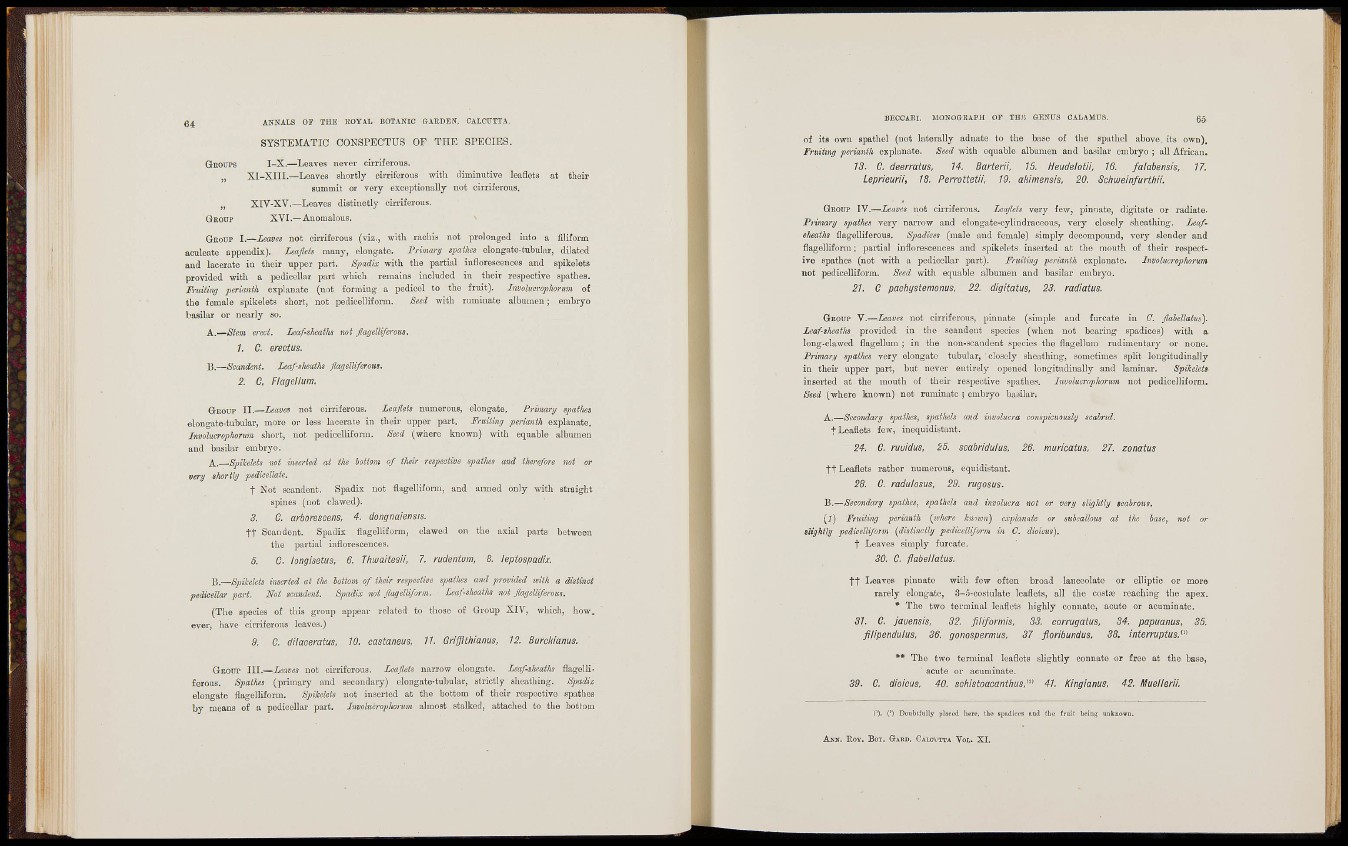
ANNALS OF THE ROYAL BOTAKIC GABDEN, CALCUTTA.
SYSTEMATIC CONSPECTUS OF THE SPECIES.
GROUPS I-X.—Leaves never cirriferous.
„ Sl-XIII.—Leaves shortly ciiTÍferous with (iimiautive leaflets at their
summit or very exceptionally not cirriferous,
„ XIV-XV—Leaves distinctly cirriferous.
GBOUP XVI.—Anomalous.
GROUP I.^Leaves not cirriferous (viss., with rachis not prolonged into a filiform
aculeate appendix). Leaflets many, elongate. Primary spaihes elongate-tubular, dilated
aud lacerate ia their upper part. Spadix with the partial ioflorescejices and spikelets
provided with a pedicellar part which remains iacluded in their respective spathes.
Fruiting perianth expían ate (not forming a pediccl to the fiuit). Invohicrophorum of
the female spikelets short, not pedicellifoim. Seed with nmiinate albumen; embryo
basilar or nearly so.
A.Stem erect. Leaf-sheaths not JlagelUferout.
1. C. erectas.
B.—Scandeni. Leaf-sheaths flagelliferous.
2. C. Flagellum.
GROUP II.—Leaves not cirriferous. Leaflets numerous, elongate. Primary spathes
elongate-tubular, more or less lacerate in their upper part. Fruiting perianth explanate.
Invohicrophorum short, not pedicellifonii. Seed (where known) with equable albumen
and basilar embryo.
A.—,
very shortly
bottom of their respectiva spathes and therefore not or
t Not scandont. Spadix not flagellifi
spines (not clawed).
1, and armed on]y with straight
3. C. arborescens, 4. dongnaiensis.
t")- Scandent. Spadix flagelliforni, clawed on the axial parts between
t h e partial inflorescences.
5. C. longisetus, 6. Thtuaitesii, 1. rudentum, 8. leptospadix.
B.—Spikelets inserted at the lottom of their respective spathes and provided with a «
part. Not scandent. Spadix not flagelliform. Leaf-sheaths not flagelliferous.
(The species of this group appear related to those of Group XIV, which, how.
ever, have cirriferous loaves.)
9. C. dHaeeratus, 10. oastaneus, 11. Griffithianus, 12. Burckianus.
GRODP 111.—Leaves not ciiTiferous. Leaflets narrow elongate. Leafslmths
ferous. Spaihes (primary and secondary) elongate-tubular, strictly sheathing,
elongate flagelliform. Spikelets not inserted at the bottom of tlieir respective spathes
by means of a pedicellar pai't. Involucrophorum almost stalked, attached to the bottom
BECCAEI. MONOGEAPH OP TH;¡ GENUS CALAMUS. 65
of its own spathel (not laterally adnate to the base of the spathcl above its own).
Fruiting perianth explanate. Seed witli equable albumen aud basilar embryo ; all African.
75. C. deerratus, 14. BarterU, 15. Heudelotii, 16. falabensis, 17.
Lepneurii, 18. Perrottetii, 19. akimensis, 20. Schweinfurthii.
GROUI* IV.—Leaves not cirriferous. Leaflets very few, pinnate, digitate or radiate.
Primary spathes very narrow and elongate-cylindraceous, very closely sheathing. Leafeheaths
ilagolliferous. Spadices (male and female) simply decompound, very slender and
flagelliforni; partial inflorescejices and spikelets inserted at the mouth of their respective
spathes (not with a pedicellar part). Fiititing perianth explanate. Involucrophorum
not pedicelliform. Seed with equable albumen and basilar embryo.
21. G pachystemonus, 22. digitatus, 23. radiatus.
GROUP V.—Leaves not cirriferous, pinnate (simple and furcate in 0. flabellatus).
Leaf-sheaths provided in tlie scandent specics (when not bearing spadices) with a
long-clawed flagellum ; in the non-scandent specics the flagellum rudimentary or none.
Primar!) spathes very elongate tubiilar, ' closely sheathing, sometimes split longitudinally
in their upper part, but never entirely opened longitudinally and laminar. Spikelets
inserted at the mouth of their respective spathes. Involucrophorum not pedicelliform.
Seed (where known) not ruminate ; embiyo basilar.
A.—Secondary spaihes, spathels and involucra conspicuously scahnd.
t Leaflets few, inequidistant.
24. C. ruuidus, 25. scabridulus, 26. murioatus, 27. zonatus
t t Leaflets rather numerous, equidistant.
28. C. radalosus, 29. rugosas.
H.—Secondary spathes, spathels and involucra not or very slightly scabrous.
( l ) Fruiting perianth (where hmun) explanate or subcallous at the base, not or
slightly pedicelliform [distinctly pedicelliform in G. dioicus).
t Leaves simply furcate.
30. C. flabellatus.
f t Ijcaves pinnate with few often broad lanceolate or elliptic or more
rarely elongate, 3-5-costulato leaflets, all the costfe reaching the apex.
* The two termiual leaflets highly connatc, acute or acuminate.
31. C. javensis. 32. fiUformis, 33. corrugatus, 34. papaanus, 35.
filipéndulas, 36. gonospermus, 37 floribundas, 38. interruptus.^'^
** The two terminal leaflets slightly connate or free at the baso,
acute or acuminate.
39. C. dioicus, 40. schistoacanthas,'^' 41. Kingianus, 42. Muellerii.
('), O Doubtfully placed Iier?, (ho spud iocs and tlxo fruit teing unknown.
ANN. ROY. BOT, GARD. CAim'TTA VOL. XI.